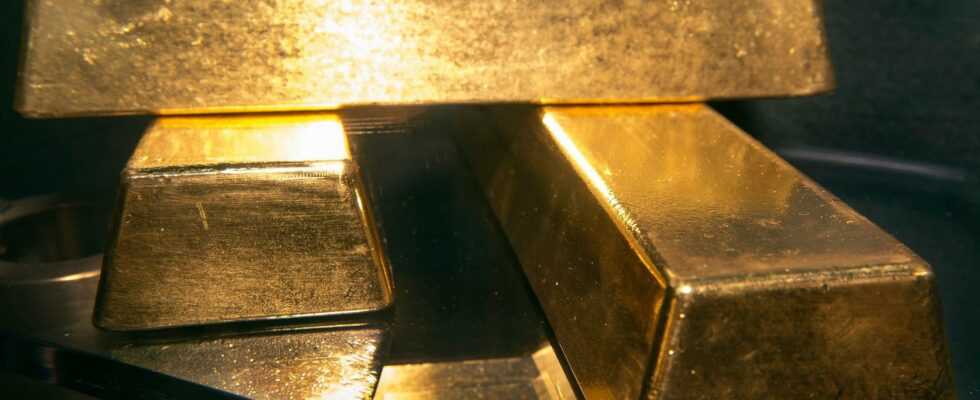(BFM Bourse) – Since it does not correspond to anyone’s debt, gold is a safe haven in the event of serious geopolitical tensions, let alone war. The conflict in Ukraine is no exception, underlines Laurent Schwartz, president of the Comptoir national de l’or, which points to the peak reached by the ounce of gold (in euros) on Thursday, the day of the invasion of Ukraine.
While the equity markets trembled on Thursday after Russia declared war against Ukraine, gold asserted its character as a safe haven to reach, at the same time, a historic high at 1,709 euros – the record in dollars n was not beaten because the greenback also took advantage of its safe haven status to appreciate significantly.
“The price of gold has risen significantly since the beginning of February as tensions around Ukraine have intensified,” notes Laurent Schwartz, president of the Comptoir national de l’or. “Market players are faced with a situation where all scenarios are possible, including that of a world war between nuclear powers. Taken aback, and faced with the difficulty of assessing the probabilities and consequences of the different scenarios, they logically turn to the only asset that cannot default or fail: gold” he continues.
If the economic repercussions of the current armed conflict, and of the economic sanctions that the West will impose in retaliation on Moscow, are at this stage impossible to quantify, they “should push inflation and anchor it for the long term” suggests Laurent Schwartz. The Russian army’s offensive has also resulted in a new surge in energy prices, the barrel of crude oil having exceeded 100 dollars on Thursday for the first time since 2014 while gas reached a historic high on the European market, as well as the prices of many metals and cereals, all raw materials for which Russia is a central player in the world market.
“In the event of sanctions/retaliations on the energy sector, we could witness a new oil (and gas) shock which would put a brake on a world economy which has already been slowing down for several months” warns Laurent Schwartz. “The result would be a drop in nominal and real interest rates, which is by nature favorable to the yellow metal,” he recalls.
“If history never repeats itself, sometimes it resonates” philosopher Laurent Schwartz, who remembers that the price of gold was multiplied by 2.8 in two years during the first oil shock (1973-1974), then by 2.5 during the second shock, between 1978 and 1980.
How Putin partly builds his strategic independence on gold
When Vladimir Putin took power in August 1999, Russia’s gold reserves amounted to 457 tonnes. They now officially reach 2,298 tonnes. In 22 years, these reserves have therefore been multiplied by five. “No other country in the world has bought so much gold over the period” emphasizes Laurent Schwartz. Russia thus now holds the 5th largest gold reserves in the world, valued at around 140 billion dollars, very far behind the United States (8,100 tonnes) but also behind Germany (3,300), Italy (2,450 tonnes) and France (2,430).
“It should first be noted that these are only official figures as reported to the IMF by the Russian authorities themselves. It is therefore possible that purchases will continue discreetly, away from international markets, from producers. national (remember that Russia is the world’s second largest producer of yellow metal, behind China” adds the president of the Comptoir national de l’or.
These massive purchases of gold by the Russian central bank are primarily explained by “the policy of dedollarization of the country’s foreign exchange reserves” he explains again. In fact, “to limit the impact of economic sanctions on his financial assets, Vladimir Putin has decided to gradually liquidate the country’s dollar assets in favor of the yellow metal which is not controlled by anyone”. “It is indeed impossible to freeze the gold assets held in the vaults of the central bank in Moscow. It is also interesting to note graphically that gold purchases by Russia accelerated from 2014, the year of economic sanctions. international following the annexation of Crimea” continues the specialist.
Another possible motivation: the yellow metal “is a safe haven which reassures and refers to the notion of wealth”. By holding the 5th largest reserves in the world, “Russia is therefore signaling that it is richer than the size of its economy (11th largest GDP in the world) would suggest,” believes Laurent Schwartz.
And the expert concludes with a final observation: the gold purchases made by Russia have already turned out to be an excellent financial operation. “Our analysis reveals that the cost price of Russia’s official gold reserves is around $1,100 per ounce, compared to a current price close to $1,900, representing an unrealized gain of more than 70%. represents a gain of approximately 60 billion dollars for the country, which is explained by the good timing of purchases, in particular their acceleration after 2014 and their cessation in 2020, before the surge which pushed the ounce beyond 2000 dollars” he explains.
Finally, it is interesting to observe that the Chinese strategy is very similar to that of its Russian ally. “Geostrategic confrontation with the United States, territorial claims and attempts at annexation (Taiwan), significant military efforts or even the desire to reduce the influence of possible economic sanctions”, the similarities between the geopolitical and economic strategies of Beijing and Moscow are blatant. As the world’s largest gold producer, China has also adopted a strategy to increase its reserves of the precious yellow metal, which stand at nearly 2,000 tonnes (+85% since 2014) according to official data.
Quentin Soubranne – ©2022 BFM Bourse
